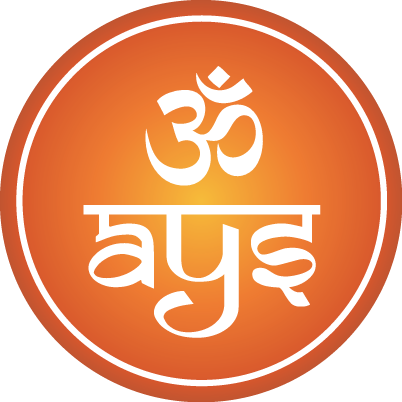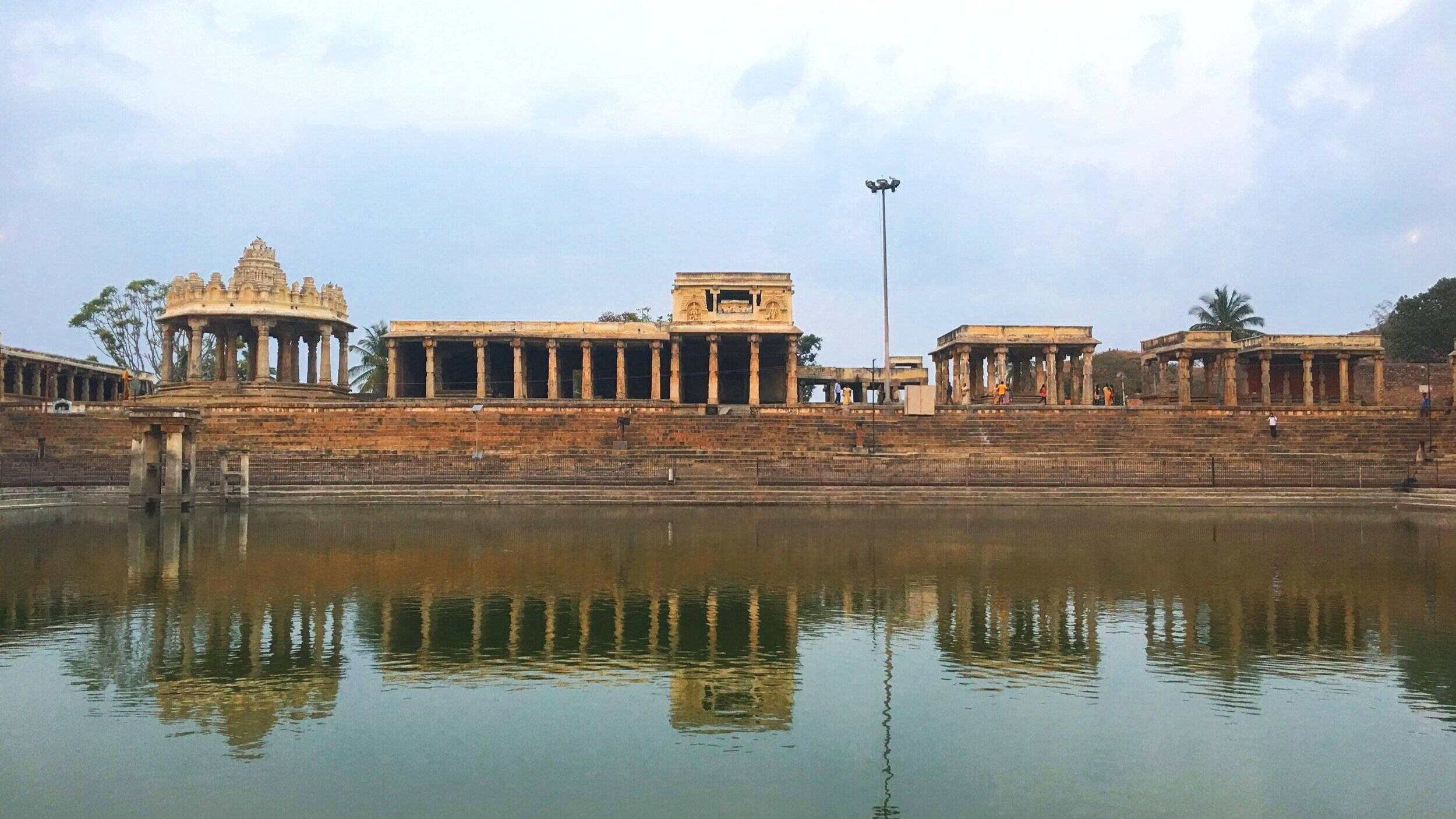Memorial Tribute to our Beloved Acharya
Sri U. Ve. Proff. M. A. Lakshmithathacharya Swami
August 26 1936 - May 15 2021
Born August 26 1936 to Panditha Raja Sri U.Ve. Alwar Tirumalai Iyengar Swami and Smt M. A. Shingamma.
We wish to pay tribute to our late Acharya
Sri U. Ve. m. A. Lakshmithathachar Swami
Swami was a true yogi of matchless compassion and wisdom. He was our spiritual teacher and he touched us very deeply. In the pages below we will commemorate his life which was full of great accomplishments. Swami was a great light in the world and made many contributions to his community. He was fearless and dedicated and commanded the respect and admiration of the entire community of Mysore. He was an icon of spiritual practice and he was dearly loved by his family and by the whole community.
For anyone who would like to learn more about Mysore Yoga Parampara and the brilliance of Indian culture and scholarship, his life is a shining example! He came from the last unbroken Parampara of the Iyengars which goes back to ancient times. By understanding something about his life, his lineage and accomplishments, we can appreciate what a light he was in this world. He is an outstanding example of academic excellence, selfless service to humanity, and he had an enormous depth of understanding in many fields of research. He was the kindest of teachers and made time for everyone who sincerely expressed interest in yoga and spiritual practice. Words cannot express our gratitude to him for his teachings. By the grace and kindness of Sri Lakshmithathachar’s son, Sri MA Alwar Swami, we have been provided with information about the Mysore Yoga Parampara that they come from. It is our great honor to share share this information. When we understand the truly awesome depth of knowledge, spiritual practice, and tradition that exists in Mysore India, we can appreciate the yoga practices that have impacted the entire world more completely.
Some words from the srivaishnava community of Mysore
Sri U.Ve. Prof. M.A. Lakshmithathacharya Swami was the head of the Svayam Acharya Purusha Parampara, which traces its lineage to Saint Ananthaacharya of Tirupati, who was a direct disciple of Acharya Raamaanuja. Over the decades, virtually all such Paramparas have declined, and many of them disappeared, leaving a spiritual void in the lives of the Shisyas and Abhimanees (spiritual aspirants) who belonged to these extinct traditions. The loss has been incalculable.
Prof. Lakshmithathacharya Swami and his illustrious ancestors have maintained their Acharya Purusha Parampara against overwhelming odds. They have resisted and successfully overcome the challenges of modern times keeping their spiritual tradition firmly in tact. Forces such as economic compulsions, declining values, rising skepticism, increasing material temptations, dilution of faith and so on were responsible for the end of other similar traditions. We are all familiar with these forces, which have frequently disrupted our own lives and caused much unhappiness. We can therefore readily appreciate the sacrifices made, and the hardships endured by Prof. Lakshmithathacharya Swami and his ancestors in order to maintain the continuity of this Parampara over so many years. Thus they have ensured that no Shishya or Abhimanee of this Parampara, belonging to any generation, has been deprived of spiritual ministration and emancipation at any stage. It is an incredible achievement. Not only that, they have kept alive the Torch of Ubhaya Vedanta and Sanatana Dharma to educate and enlighten all sections of society down the Ages. It is a miracle, which could not have taken place without the time honored qualities of true scholarship, spiritual strength, firm conviction, foresight and abiding compassion on the part of successive Acharya Purushas of this unique Svayam Acharya Purusha Parampara.
In the past the Svayam Acharya Purusha was considered ‘public property’. The Parampara was regarded as a precious, and indispensable Institution. Family Elders and Shisyas of a Swami were always seriously concerned about the continuation of the Tradition. They felt that they had a right to intervene whenever anything happened which was viewed as detrimental to the Tradition or posing a potential danger to its continuation. They remained vigilant. In the Parampara, to which our Swami belonged, there have been many such instances of concern and proactive intervention. Tarakateertha Lakshmithathacharya Swami, the Grandfather of the present Swami, was studying in a High School at Chennai. He showed exceptional proficiency in mathematics and science. At this stage, Shisyas began to clamor for his return fearing that such an education would tempt the future Swami to abandon the Parampara for more lucrative professions. Their logic may have been right or wrong but their concern was genuine and their motives absolutely unimpeachable. So the young and brilliant Swami had to return without completing this line of education and to take up the traditional mantle for which he was destined.
In the case of Prof. M.A. Lakshmithathacharya himself, a similar incident took place. After Swami had appeared for the Lower Secondary Examination, he eagerly awaited the results, as any bright lad would have done. Time passed but Swami could not find out how he had fared in the examination. Each time he made enquiries, his Father or other Family Elder would tell him that the results had been withheld due to some problem, which they would not explain clearly in any case. Meanwhile, Swami had to continue his traditional studies. After one full year, Swami came to know that he had passed in First Class and that the excellent result had been deliberately concealed from him for fear that he would go in for higher education in English and discard his traditional role for a more remunerative and attractive career. Swami’s initial reaction was one of disappointment and resentment. Several ‘well-wishers’ urged him to leave the Vedic Tradition saying, “There is no future in this. You are a brilliant student. Study engineering or medicine. Make money.” This compounded Swami’s dilemma. Years later Swami realized the wisdom and foresight of his revered Father and of those who were a party to that ‘deception’. He was very grateful to them in hindsight.
Sri U.Ve. Prof. M.A. Lakshmithathacharya and his wife, Ammangar M.A. Godha, have resisted all the forces operating against the survival of the Paramapara by making sacrifices at ever step, undergoing material and mental hardships, trusting their own instincts based on their own convictions, and never losing sight of their higher goal in life. Ammangar Godha’s learning, wisdom, wise counsel, personal sacrifices, and firm support throughout always complimented Swami’s own outstanding efforts. Her support was critical to Swami in all his achievements. They not only devoted their own lives for the larger good of their Shisyas, Abhimanees and the Community as a whole, but they groomed both their sons in traditional education and the ‘vaidic’ way of life rooted in our Shastras and spiritual traditions. All parents desire that their offspring should enjoy material prosperity and happiness in life. But which parents have the wisdom, courage as well as the vision to sacrifice the material wealth and worldly prospects of their children for the sake of the spiritual wealth and well being of the community as a whole? One may have to search the ‘Puraanas’ to find such instances but the example of Prof Lakshmithathacharya Swami and Ammangar Godha can be seen before our eyes today. Their sons could have excelled in any of the lucrative careers of our times, amassed great material wealth and acquired the transient prestige associated with it. But these temptations were resisted and the sacrifices made. Thus, they have ensured that at least their children and grandchildren are assured of a fully educated Swami and will not be forced to wander about in a spiritually barren desert.
As students of Prof. M.A. Lakshmithathacharya, we are bringing out this information to acquaint the public with Swami’s Lineage, the achievements of his Illustrious Ancestors, his life, works and his many achievements. He was truly a pillar of inspiration in the Srivaishnava Sampradaya and Traditions. The information given here is based on various sources such as Swami’s own research and articles, books and articles written by others including some members of Swami’s family, evidence of inscriptions, valuable inputs provided by Swami’s close relations as also some well-informed Shisyas and Abhimanees. We received tremendous information and insight, particularly, during the course of several interviews given so patiently by Swami despite his busy schedules. As the compiler of this information, we accept responsibility for any inaccuracy or shortcomings in telling the story of the great U. Ve. Proff. Lakshmithathacharya Swami.
Swami Ji made time to teach anyone sincerely interested in spiritual practice.
His teachings touched people all around the world. He would patiently teach anyone, young or old, no matter what level they were at.
An article from the hindu newspaper
Renowned Sanskrit scholar and founder-director of the Academy of Sanskrit Research, M.A. Lakshmithathachar, passed away at the age of 85. Born on August 26, 1936, Dr. Lakshmithathachar studied Sanskrit and specialised in literature, Navya Nyaya system of philosophy and various systems of Vedanta with special reference to Vishistadaitha Vedanta, comparative studies of Sanskrit with modern schools of thought, study of scientific subjects in Sanskrit like phonetics etc.
Dr. Lakshmithathachar headed the Academy of Sanskrit Research for 25 years and before that he taught Sanskrit at the Government College in Chitradurga, Government Arts and Science College in Bengaluru, and was the Assistant Professor of Sanskrit in the PG Department of Bangalore University.
As the Director of the Academy of Sanskrit Research, he was responsible for the publication of various multi-volume critical works of Sri Ramanujacharya, the Upanishads and other rare works in Sanskrit.
He was also responsible for the preparation of thematic descriptive catalogue and bibliographies on palm leaf manuscripts, preparation of critical editions of unpublished manuscripts with special reference to medicinal manuscripts among others.
He was among the first to harness computer software to study ancient manuscripts. Dr. Lakshmithathachar had received the Presidential award. He also played the lead role in the film Ramanujacharya, directed by G.V. Iyer.
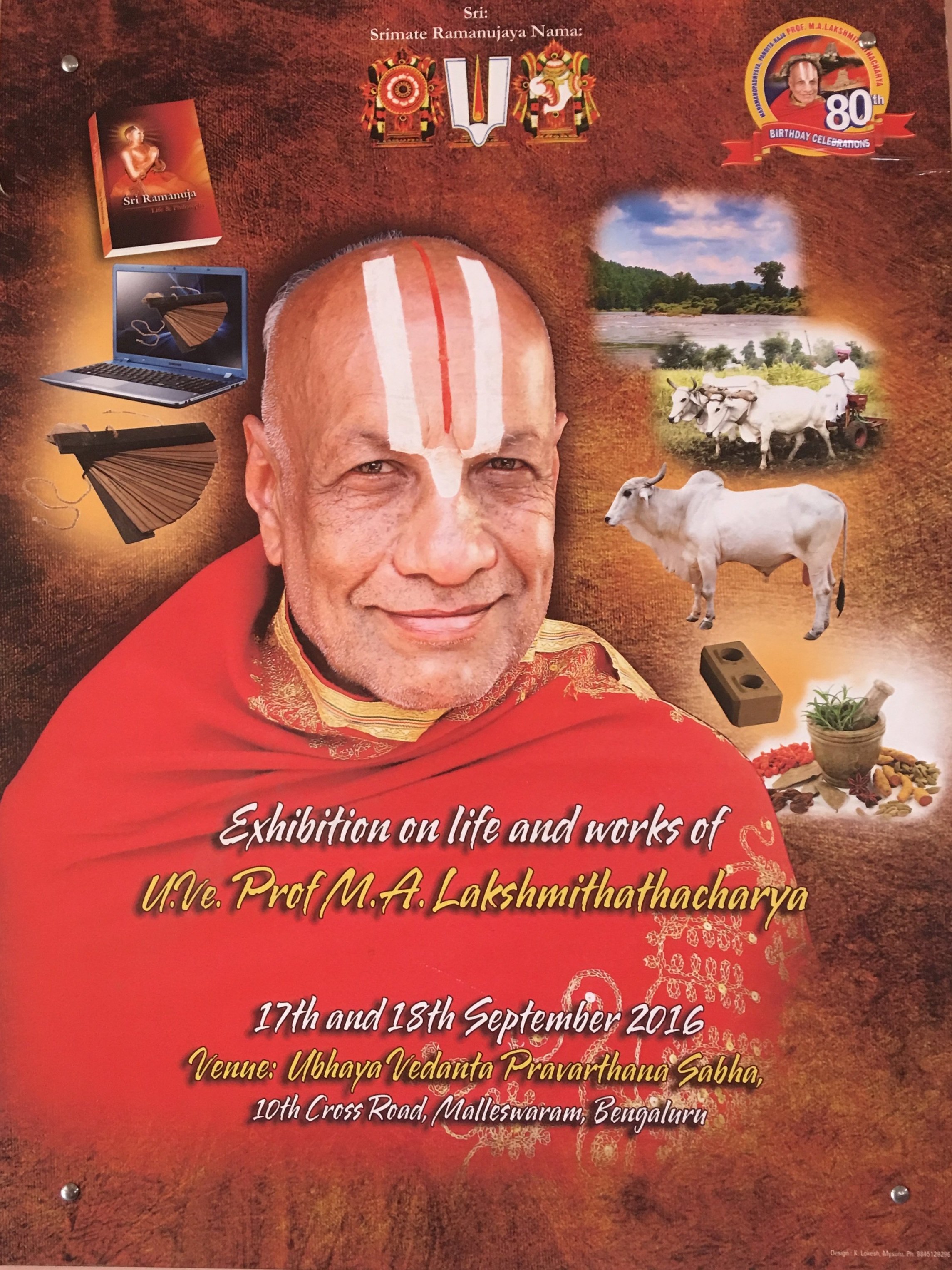

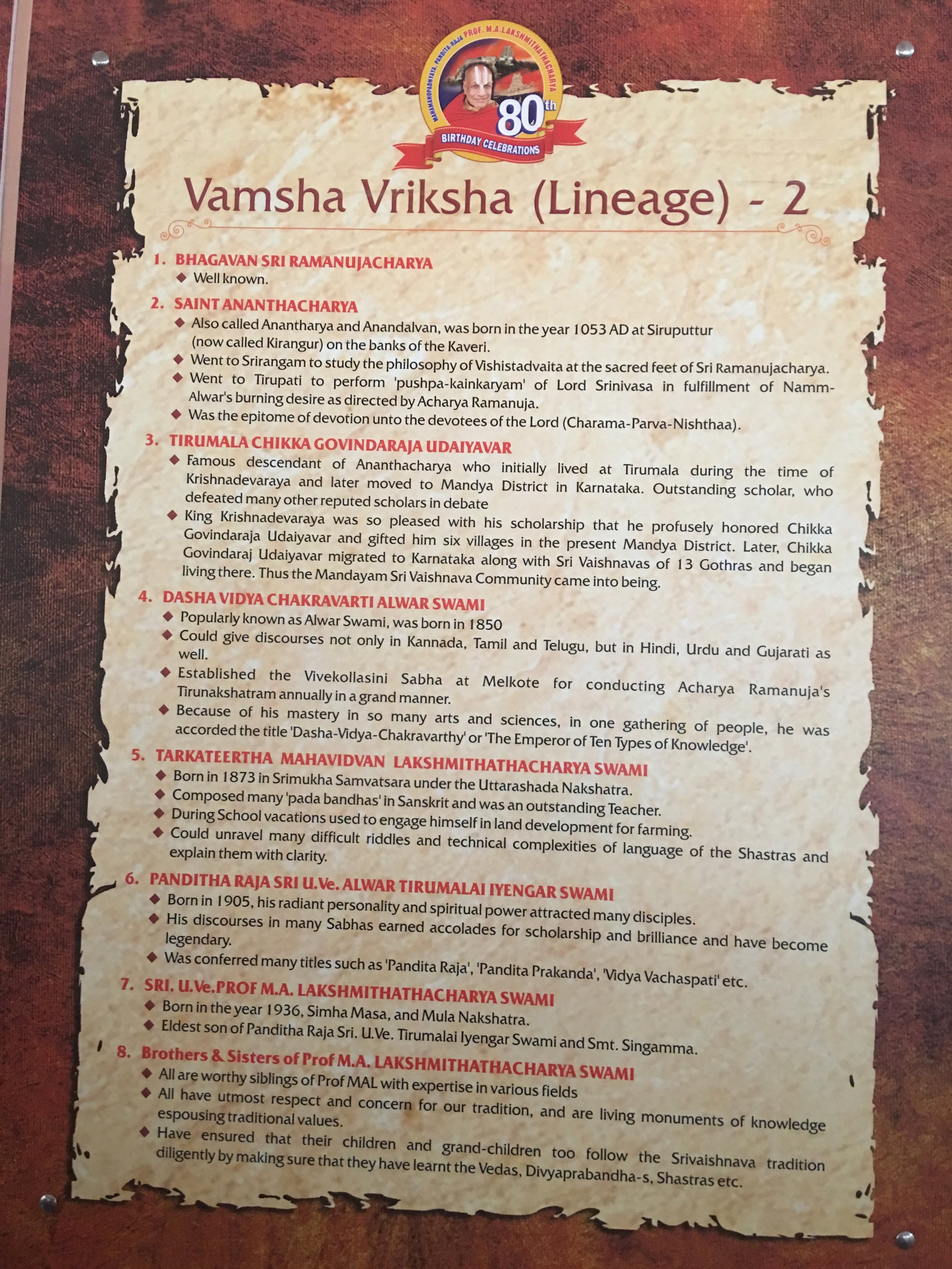
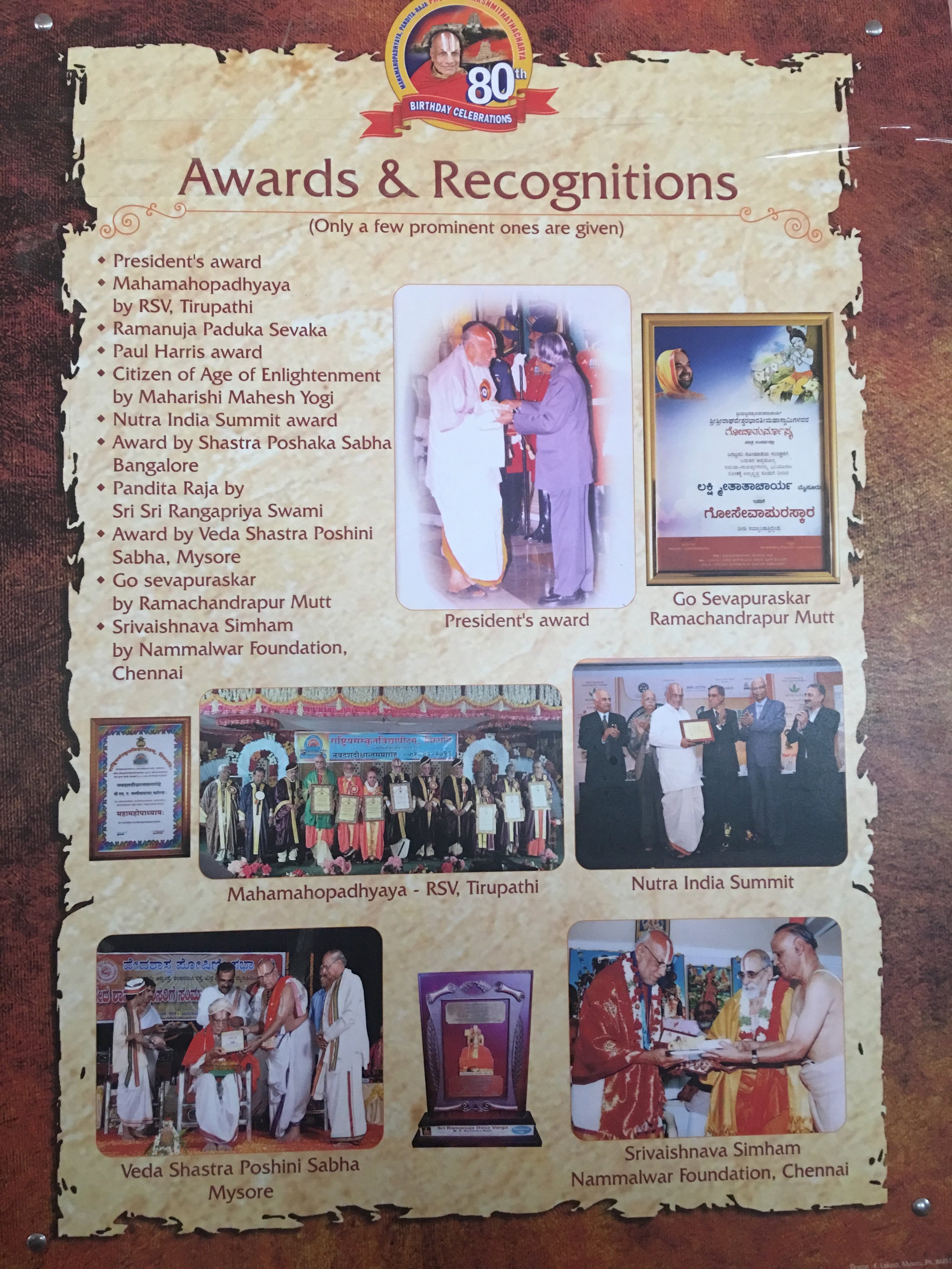
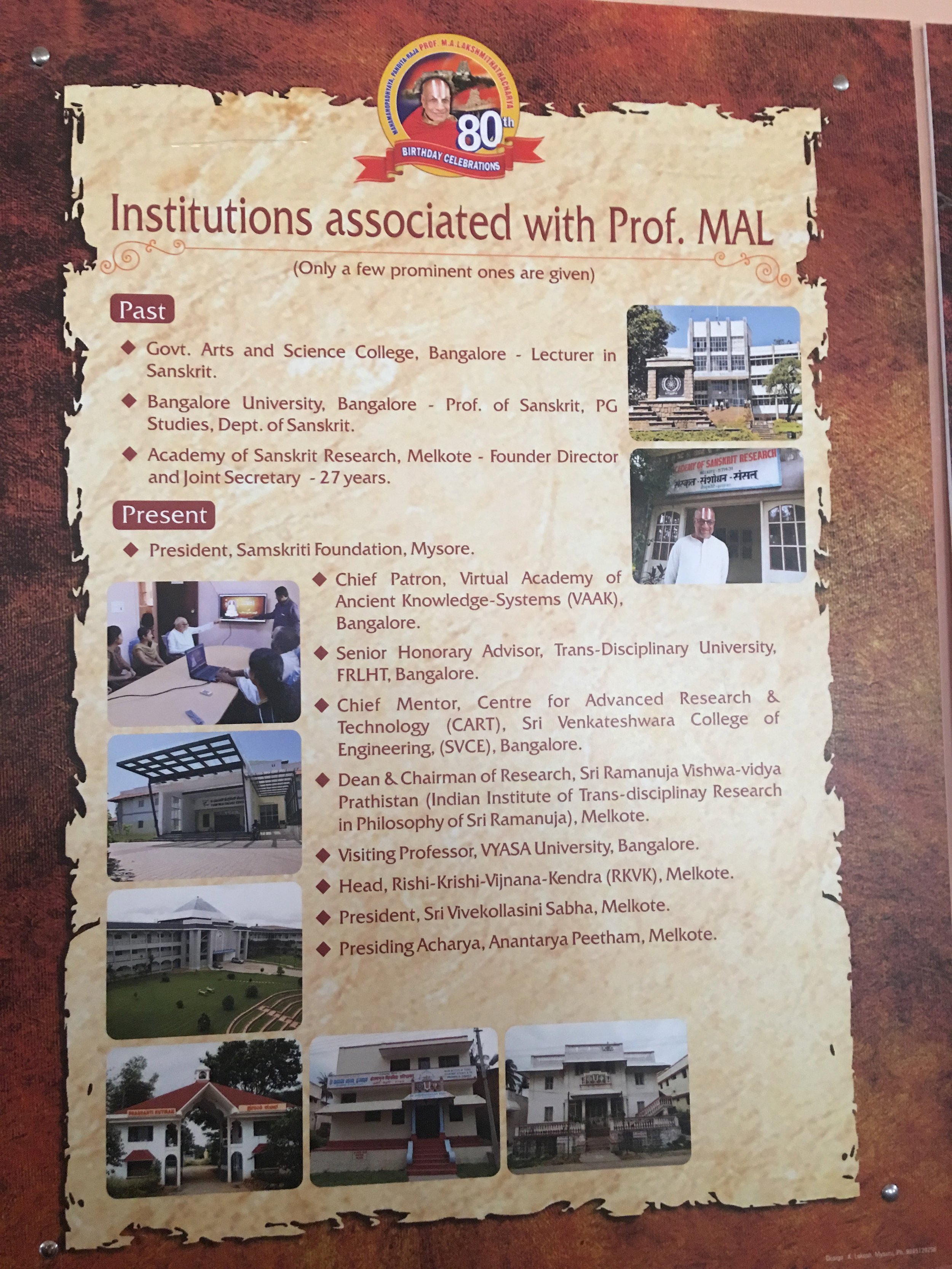
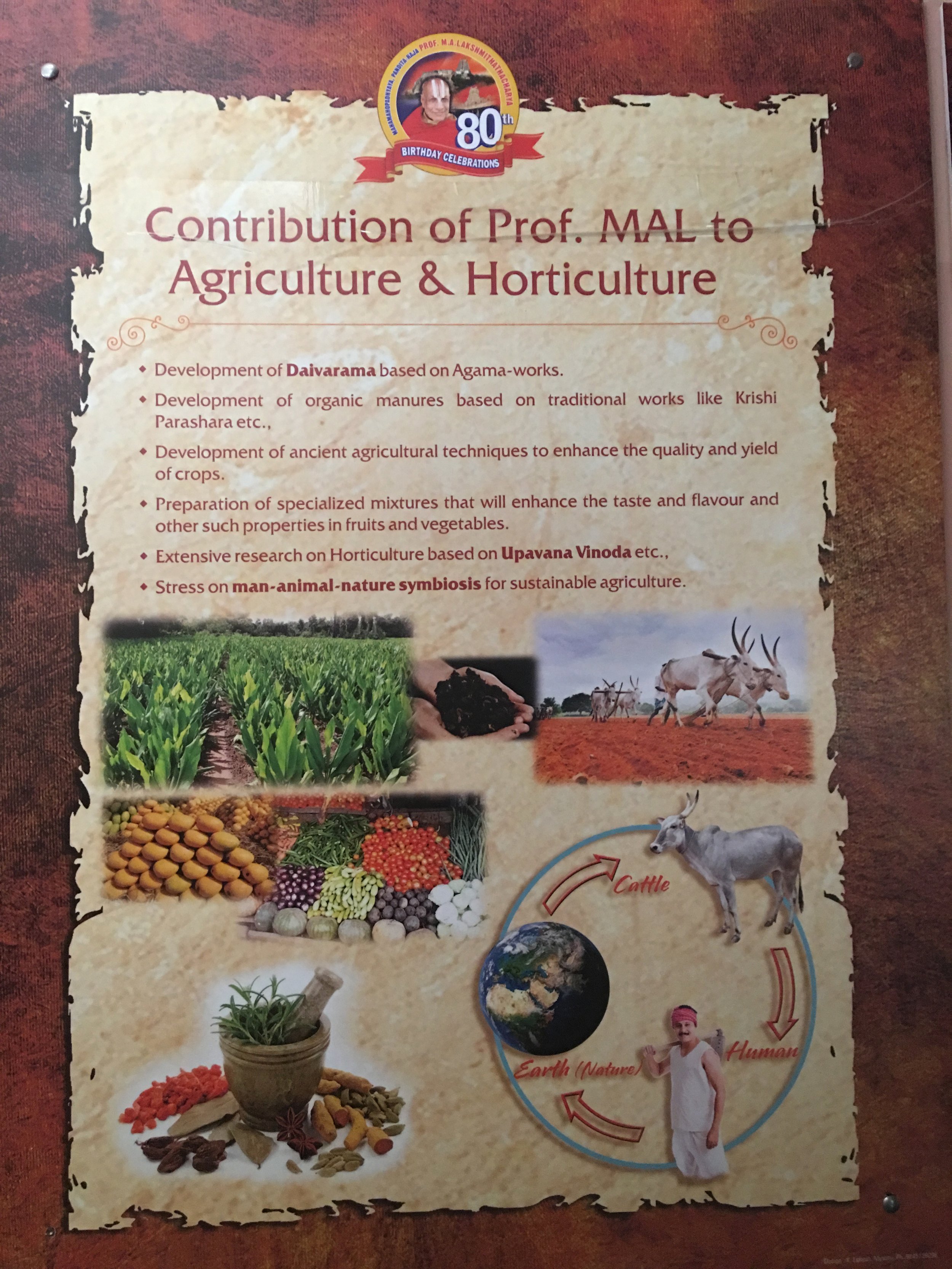
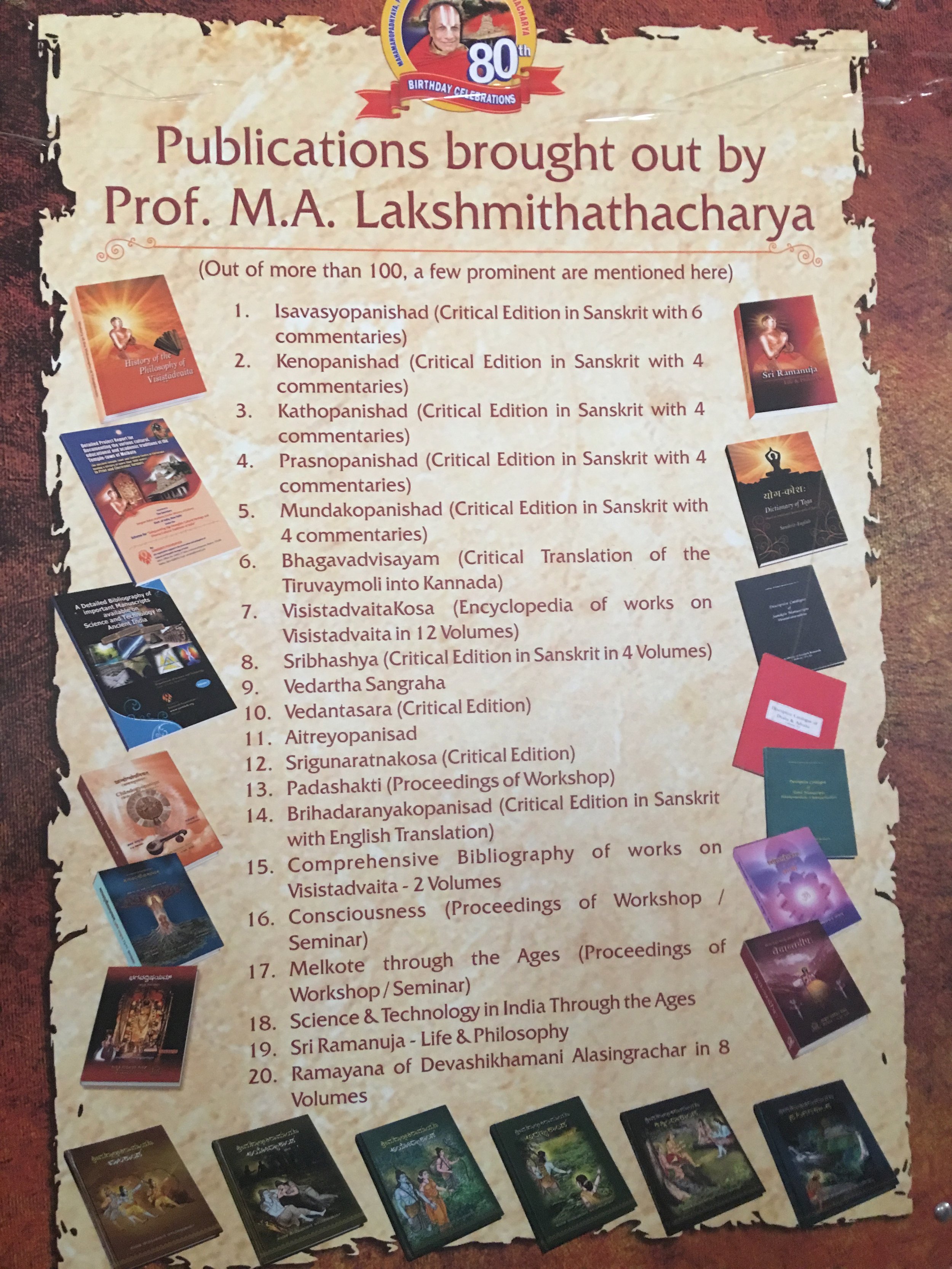
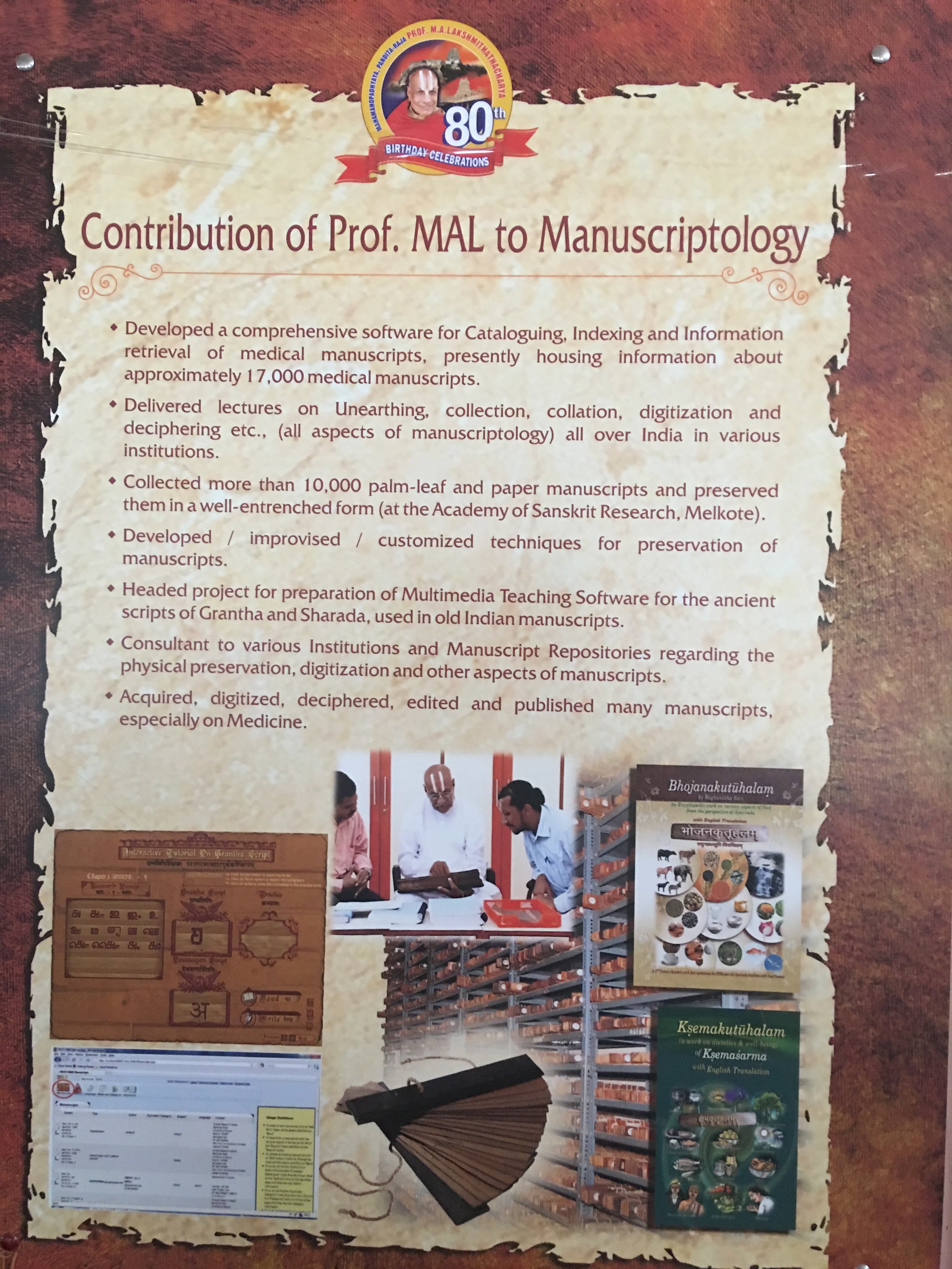
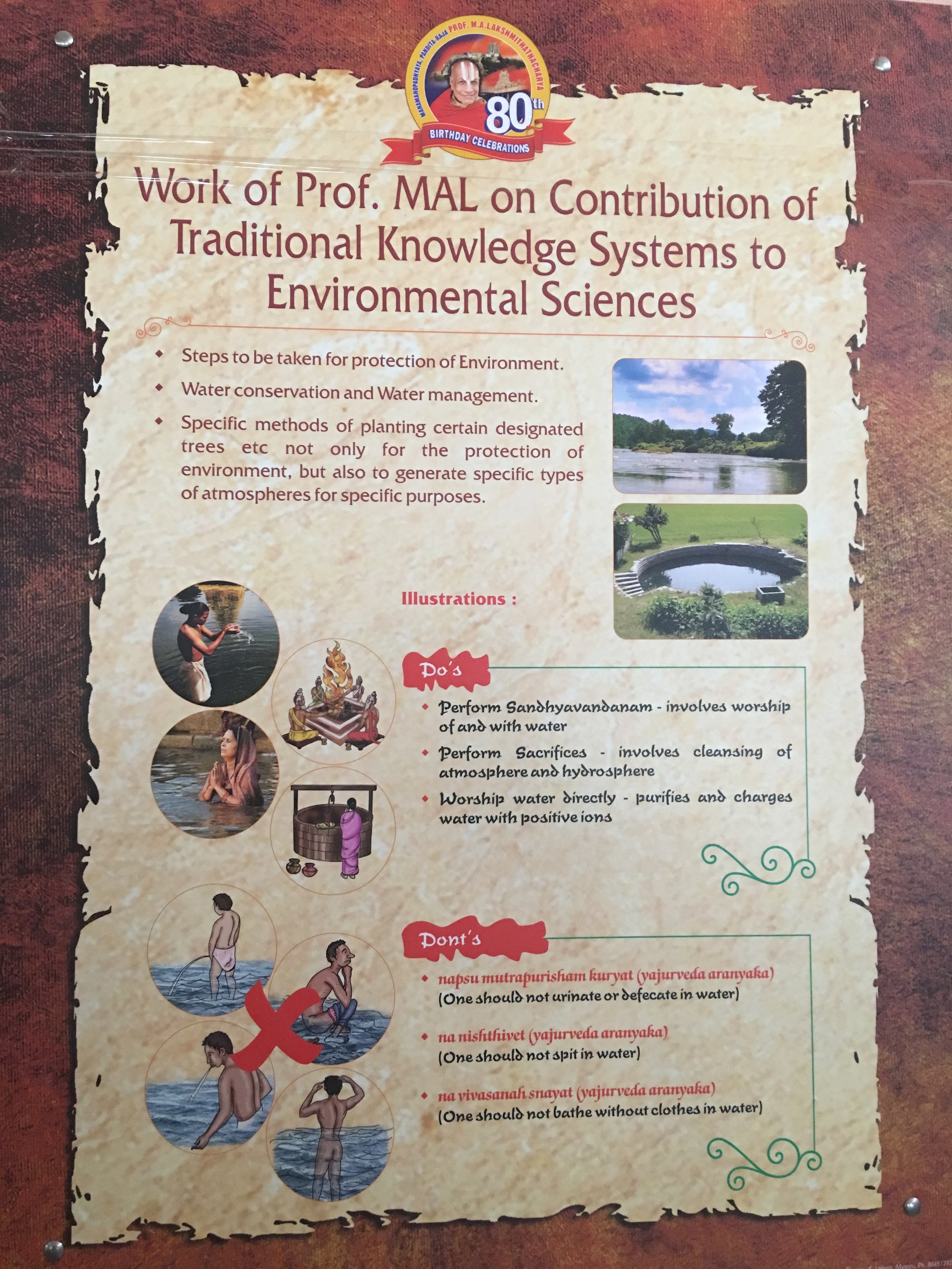
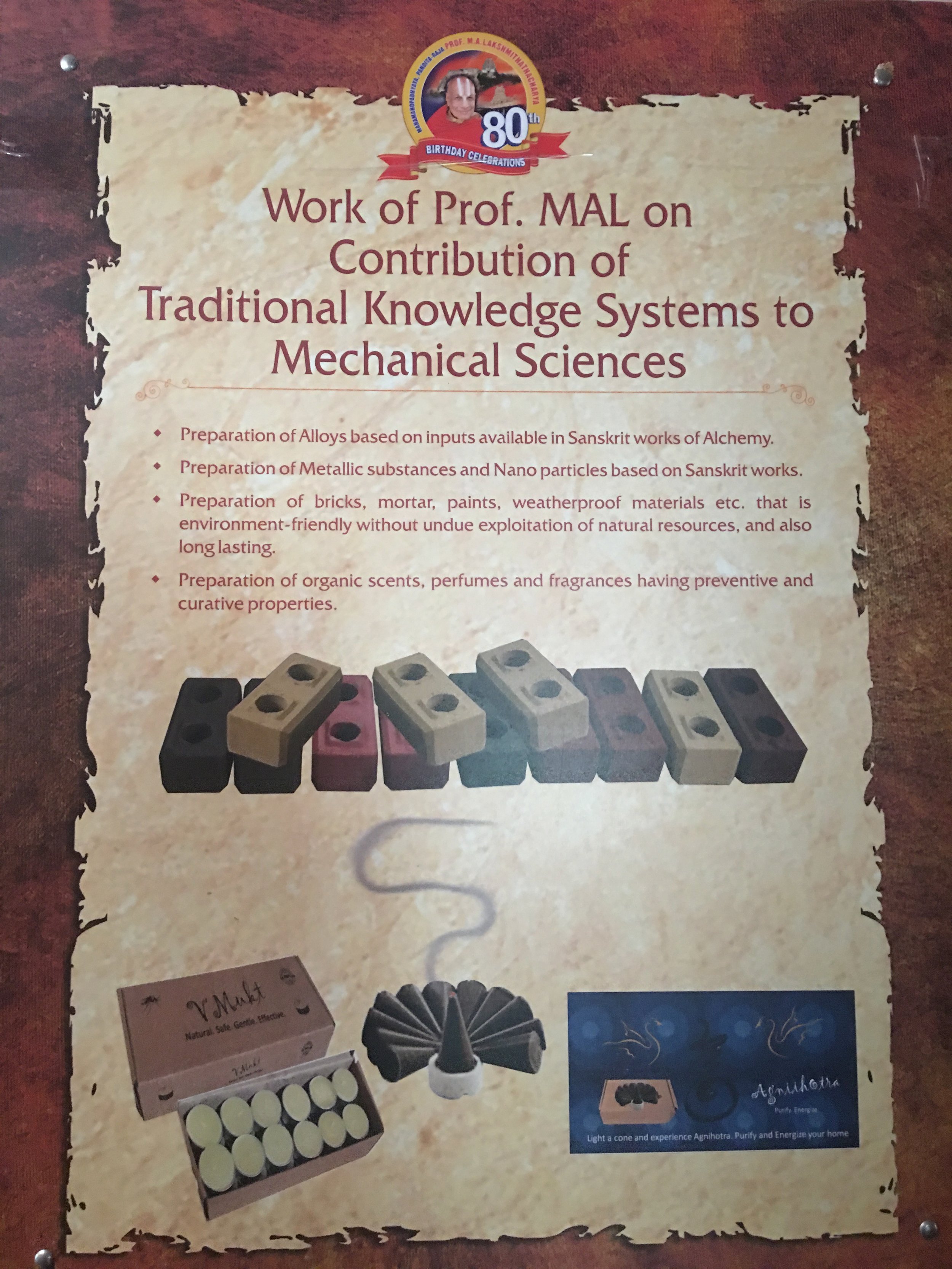
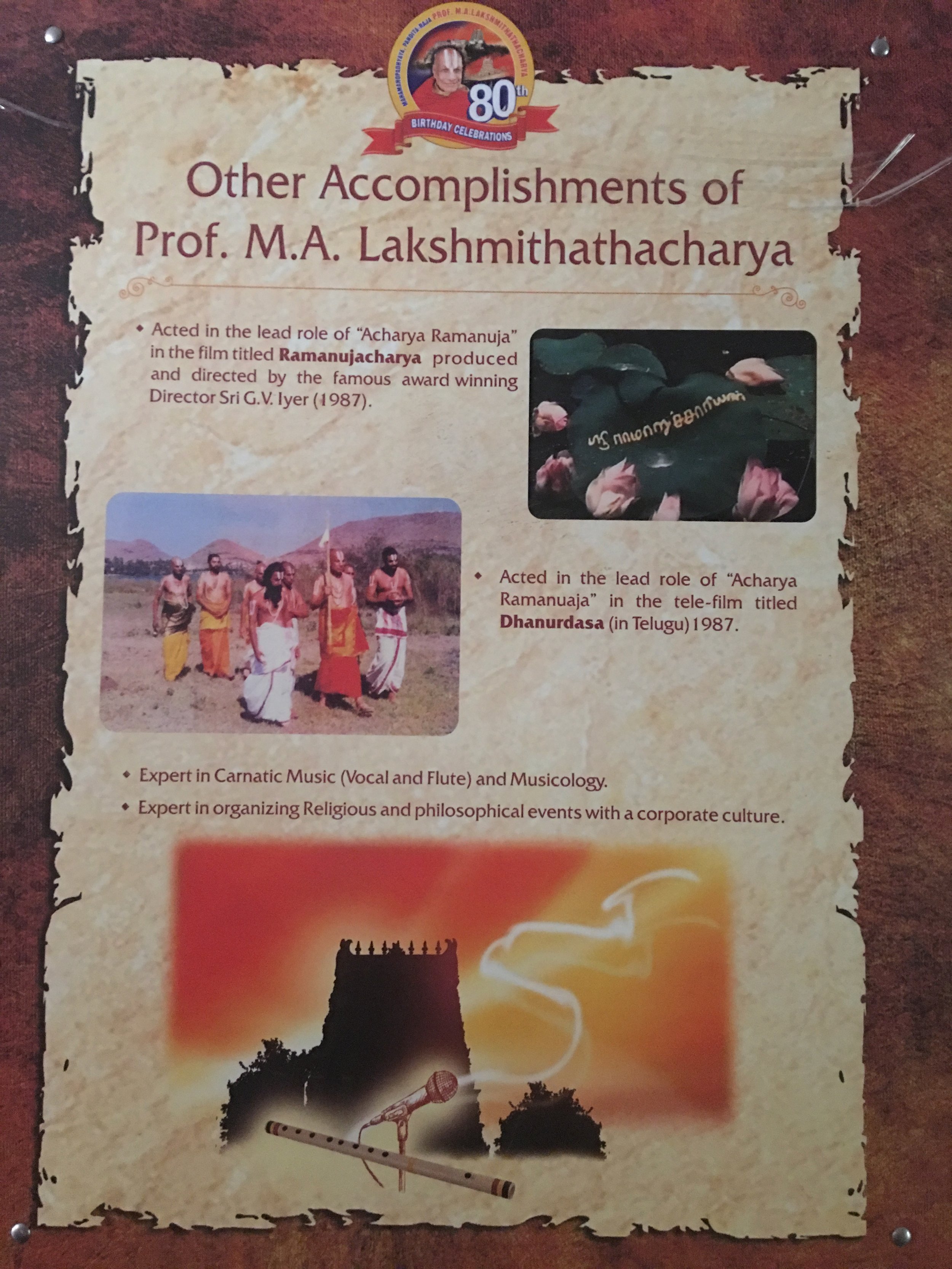
Spiritual Lineage of Sri U. Ve. M. A. Lakshmithathachar Swami
BRIEF HISTORY OF THE MANDAYAM SRI VAISHNAVA COMMUNITY
Iyengars constitute a community amongst Tamil Brahmins largely found in Tamil Nadu, Karnataka and Andhra Pradesh but otherwise all over India and the world. Iyengars worship Lord Sriman Narayana and are called Sri Vaisnavas. They follow the teachings of the Philosopher-Saint Acharya Raamaanuja. This is called Ubhaya Vedanta, which accords equal importance to the ancient Vedas in Sanskrit and the Divya Prabandams of the Alvars in Tamil.
The word “Iyengar’ is the anglicized form of the Tamil word ‘Aiyankaar’ which implies ‘people entrusted with the five duties’. ‘Iyengar’ in Tamil actually means “ Aindhu Angam Udayavan” or “Aindhu Kaaryangal Udayavan”. These five duties are termed ‘Pancha Samskaaram’. This can only be done by an Acharya of the Sri Vaishnava Parampara. ‘Samashrayanam’ means ‘to approach (the Acharya) in all sincerity’. If one is extremely lucky, the Acharya may be merciful enough to agree to initiate one as a Shishya and perform the ‘Pancha Samskaaram’. Then one gets the link to the Sri Vaishnava Paramapara. Only then does one become a ‘Sri Vaishnava’ and may be rightfully called an ‘Iyengar’.
All Iyengars trace their ancestry to one of the 74 ‘simhaasanaadhipathis’ (saints) appointed by Acharya Raamaanuja. The Mandayam Sri Vaishnava Iyengars trace their ancestry to Saint Ananthaacharya who lived in an Agraharam called “Mandayam” in Karnataka before going to Srirangam to become a disciple of Acharya Raamaanuja. Later he went to Tirumalai at the behest of the Acharya and settled down there, performing daily ‘pushpa kainkaryam’ of Lord Venkateshwara.
Saint Ananthaacharya’s descendants continued to live in 4 villages around Tirumalai, which were, named after ‘Mandayam’ to commemorate their old link to the Agraharam in Karnataka where Ananthaacharya once lived. There is substantial concrete evidence to prove that the word ‘Mandayam’ dates back to the hoary past and Ananthaacharya has a close and inextricable association with this term.
In the 14th Century (1380), Sri Periya Govindraja Wodevar hailing form the dynasty of Ananthaacharya received a gift of 21 villages in the Attiguppa Taluka of the present Mandya District in Karnataka. He settled down at Srirangapatnam as the Raja Guru (guru to the king) of Sriranga Raaya. Later another descendant of Ananthaacharya, Chikka Govindaraj Wodevar who was residing near Tirumala at the time of Krishnadevaraya, defeated a Shaivite Scholar in a famous debate and was granted six villages in the present Mandya District. He and his people then moved from Tirumalai to these villages and thus the Mandyam Community came into being.
Srimate Ramanujaya Namaha
Srimad Anantaarya Mahaguruve Namaha
SPIRITUAL & PHYSICAL LINEAGE
Amongst the successive Acharyas of the Srivaishnava Tradition, the spiritual lineage starting with Sriman Narayana himself and adorned so brilliantly by Nathmuni and Yamunamuni, Raamaanujacharya stands out resplendent and unique. Raamaanujacharya was an embodiment of matchless compassion and firm commitment to the philosophy and ideals propagated by the Srivaishnava Acharyas before him. He was prepared to sacrifice his own spiritual emancipation for that of all living beings. Hence, he was hailed as Kripamatra Prasanaacharya.
He was the great social reformer who brought all people together under the banner of bakhti and self-surrender, irrespective of caste, creed or sex. In the Sri Vaishnava tradition established by Acharya Raamaanuja, women were given equal status. A firm tenet of this tradition was that even Sriman Narayana might not be able to retrieve an individual soul lost in the ocean of transmigration without the help of His ever-compassionate spouse Goddess Lakshmi. In the spiritual traditions imbibed by Raamaanuja from his illustrious predecessors, he accorded the utmost importance to Sri Andal and continuously chanted the Tiruppavai as it contained the essence of all the Vedas, both Samskruta and Dravida.
Amongst thousands of disciples Acharya Raamaanuja had, he accorded the status of ‘Simhaasanaadhipathis’ to just 74 of his disciples. He felt that only these 74 truly great disciples would be able to successfully carry out his orders not only to propagate the Sri Vaishnava Siddhanta, but to also implement in practice his philosophy whose aim was to uplift the downtrodden masses in the spiritual plane.
Ananthacharya was foremost among disciples of Raamaanuga and the father of the Anandaanpillai Simhasanaadhipathi Paramapara.
In the line of successive Acharyas belonging to the Anandaanpillai Simhasanaadhipathi Paramapara, the names of Periya Govindaraj Wodevar and Tirumala Chikka Govindraj Wodevar stand out. Both were great scholars and spiritual leaders in their times. The former settled down at Srirangapatnam as the Raja Guru of Sriranga Raya, the Ruler of Mysore who was related to the King of Vijyanagara. The latter is the progenitor of the Mandayam Srivaishnava Community.
The major portion of the Mandyam Srivaishnava Community traces their origin to Ananthaacharya. Some of the other Acharya Purushas of this community are the ‘Prativadibhyankarams, Mudumbais, Baladhanvis, Krishnakumars, Gomatthams etc.
Due to various reasons, the Acharya Purusha (Simhasanaadhipathi) traditions of the other Simhaasanaadhipathis except the Anandaanpillai Parampara have not continued. Even amongst the various branches of the Anandaanpillais such as Manikarnikes, Raamaanujapurams, Appalachaars, Ayyapattais and others, only the Acharya Purusha tradition of the Mandyam Anandaanpillais has continued unbroken and still survives by God’s grace and the persistent efforts of all the previous generations belonging to this tradition.
The spiritual and physical lineage of the Mandayam Anandaanpillai Parampara together with the attainments and achievements of the Acharya Purushas who graced this line are given in detail here. It may be noted that from Periya Lakshmithathacharya Swami onwards, the spiritual and physical and lineages have run concurrently without a break to this day. U.Ve. Prof. M.A. Lakshmithathacharya Swami was the Acharya Purusha of this very tradition.
It is difficult, if not impossible, for most of us to realize the enormity of the efforts put in, all the sacrifices made, and the pressures resisted by these Acharya Purushas to maintain the Acharya Purusha Tradition even as times changed and adverse influences grew in intensity. Macaulay’s System of Education under British Rule sowed the seeds of doubt and disbelief in our own ancient and time-tested traditions. The temptation to gain pecuniary benefits through modern education especially by learning English, confronted the families of many Acharya Purushas with disastrous consequences for traditional learning and the continuance of their Paramparas. The Acharya Purushas of the Mandayam Anandaanpillai line were able to struggle successfully against this tide because Family Elders and Shisyas remained vigilant. Any attempt to wean a future Swami away from the tradition was nipped in the bud. Any incident, however small, was observed, noted and reported for immediate corrective action if it was felt that there would be some adverse effect upon the continuance of the Acharya Purusha Tradition. There are many instances of such vigilance and concern..
Even today, Family Members of the Swami as well as Shisyas have a very significant role to play in either preserving or destroying this unique and only surviving Acharya Purusha Parampara. Every year, the trends of modern life grow more and more hostile to the continuation of the Acharya Purusha Parampara. Shisyas and Family Members have to exercise increasing vigilance and be more and more proactive. One way or the other, the future of this time-honored and priceless tradition is in their hands.
INTRODUCTION TO SOME OF THE GREAT ACHARYAS IN SWAMI’S LINEAGE
SAINT ANANTHACHARYA
Saint Ananthaacharya also called Ananthaarya and Anandaalvan was born in the year 1053 AD at Siruputtur (now called Kirangur) on the banks of the Kaveri. He was the son of Sri Keshavaacharya of the Bharadwaj Gothra.
His early education in the Shastras was under his father. Later he went to Srirangam to study the philosophy of Vishistadvaita at the sacred feet of Sri Raamaanujacharya. Probably, Chottai Nambi, Maradur Nambi and Tondanur Nambi, all from Karnataka, accompanied him. Acharya Raamaanujaa entrusted the new disciples to the care of Dayapala Muni, otherwise known as Arulala Perumaal Emberumanaar, and requested him to initiate them into Sri Vaishnavism. Later, Dayapala Muni was so impressed with Ananthaacharya’s genius that he requested him to continue further studies under Acharya Raamaanujaa.
Amongst the 74 ‘Simhaasanaadhipathis’ (most of them were ‘Grihastaas’ or Householders), Ananthaacharya, who was conferred the title of ‘Anandaanpillais’ by Raamaanuja himself, is peerless. Once, during a discourse of Nammalvar’s Tiruvaimozhi, especially the Pasuram ‘Ozhivil Kalamellam’, Acharya Raamaanujaa expressed his wish before his disciples that someone should go to Tirupati to perform ‘pushpakainkaryam’ of Lord Srinivasa in fulfillment of Nammalvar’s burning desire. It was a dangerous mission involving physical risks and discomforts. More than that it involved separation from the divine presence of Acharya Raamaanujaa. Ananthaacharya was the only one amongst hundreds of disciples present who agreed to carry out the Acharya’s behest. Pleased with Ananthaacharya’s courage and devotion, Acharya Raamaanujaa declared, “ You are the only ‘aanpillai’ i.e. man among this assembled gathering. You have shown your manliness by daring to go to Tirumala, which is surrounded by thick forests with wild life and having chilly weather while also accepting separation from me”. In Tamil the full form is ‘Aananthaan Aan Pillai’. Henceforth, Ananthaachaya was called Aanandaanpillai. All his descendants came to be called Aanandaanpillais.
Laboring single-handedly with great dedication and tenacity, Ananthaacharya dug a tank called ‘Raamaanuja Putreri’, and used the water stored therein to create and sustain a most beautiful garden full of lovely, fragrant flowers growing in abundance. He used these flowers to perform daily ‘pushpakainkaryam’ of Lord Srinivasa. His only aim was to always execute his Achaarya’s orders with absolute sincerity and honesty. Tirumala in its entirety is regarded as a ‘pushpamantapa’ as Lord Venkateshwara, residing there, alone enjoys the fragrance of the flowers all round. He was the personification of deep devotion to one’s Acharya. A man of iron will and firm resolve, nothing could deter him from carrying out his Acharya’s commands. These qualities enabled him to fulfill the great dream of Nammaalvar and Raamaanuja. His spiritual stature can be judged from the fact that he was on talking terms with Lord Venkateshwara himself. No one can ever think of Tirumala without invoking the name of Ananthaacharya, the great man who hailed from a small village in Karnataka called Siruputtur (Kirangur) near Srirangapatna on the banks of the Kaveri.
Later, his descendants came to live in four villages near Tirupati called Ilaiya Mandyam. Gajalu Mandyam, Tirumandyam and Chinnamandyam. Ilaiya Mandyam’ also known as ‘Balamandyam’, is located nearly 4 kms from Tiruchhannur. It was built according to the instructions of Ananthaacharya himself. It is quite probable that these villages were named after an old Agraharam in Kanataka called Mandayam where Ananthaacharya lived earlier. There is evidence to suggest that the word ‘Mandayam’ is of ancient origin and closely linked to Ananthaacharya.
Ananthaacharya created the ‘Tirunandanavanam’ or Flower Garden for the Worship of the Lord at Tirupati. Once, he was digging a tank for irrigating this Garden. The Lord, disguised as a brahmachari, attempted to take part in this kainkaryam. Ananthaacharya hurled a crowbar to chase away this ‘brahmachari’. Even today, one can see a crowbar at the Tirupati Temple entrance and camphor applied to the Lord’s wound, which testify to this divine event.
There are many other miraculous incidents, which tell us a lot about the noble qualities of Ananthaacharya and testify to his close association with the Supreme Lord. These incidents have inspired generations of devotees enhancing their faith and devotion to the Lord as well as their Acharyas, and giving them spiritual strength and solace.
Once when Ananthaacharya was busy preparing a garland for the Lord in accordance with Acharya Raamaanuja wishes, he received a summons from the Lord himself. He declined to go because the flowers were on the point of blossoming and it was his duty to prepare and offer the garland to the Lord at just the right time. Later, when he went to the Lord and offered the completed garland with devotional fervor, the Lord declined to accept it because he had disobeyed the Lord’s summons received earlier. Though deeply pained, Ananthaacharya told the Lord that it was immaterial to him whether the Lord accepted his garland or not as he had the satisfaction of discharging the responsibility of kainkaryam entrusted to him by his preceptor, Acharya Raamaanuja. Such was his devotion to his Acharya and the courage of his convictions.
On another occasion, Lord Srinivasa playfully told Ananthaacharya to go away from Tirumala because Ananthaacharya was not obeying the Lord’s commands. Ananthaacharya replied that since both of them had come to Tirumala from elsewhere and settled there, and since the Lord had come to that place not too long ago, the Lord had no right had no right to order him to leave Tirumala. He pointed out that neither the Lord Venkateshwara nor himself was the owner of the hill. Only, Tirumalai Alvar i.e. Varaha Perumal is the real owner. Such was Ananthaacharya’s rare courage and presence of mind.
In another incident, a poisonous snake bit Ananthaacharya who declined any treatment to remove the poison. When Lord Srinivasa asked him the reason, he explained that if the serpent that had bitten the other serpent i.e. himself (Ananthaacharya being the incarnation of Aaadishesha) happened to be more powerful, he would get to bathe in the celestial Viraja River and have the darshanam of Lord Vaikuntanaatha (after his death). But if it were the other way round, he would be able to bathe in the Tiru Koneri and get the darshanam of Lord Tiruvengada. He stood to gain either way! Outstanding courage and faith indeed!
Ananthaacharya regarded the individual Soul as the ‘bride’, the Lord as the ‘bridegroom’, and the Preceptor to be the ‘Father of the Bride’ who was ever anxious to give his daughter away in marriage to the Lord. Every devotee should read how Ananthaacharya became the Father-in-Law of Lord Srinivasa. Ananthaacharya never allowed anyone to enter the garden created by him for worshipping the Lord with flowers. But Lord Srinivasa began to visit the Garden secretly at night, plucking flowers and breaking branches. When his disciples failed to catch the intruder, Ananthaacharya himself kept vigil. Then it so happened that Ananthaacharya spotted Lord Venkateshwara and his celestial spouse Padmavathi disguised as a royal couple and gave chase. The Princess was caught and tied to a tree while the Prince got away.
In the meantime, when the Archakas opened the doors of the Temple, they were horrified to see the Lord’s chest bare without Goddess Lakshmi. While the Archakaas were being punished for the alleged theft, the Lord himself revealed to the Archakas that Ananthaacharya had tied his spouse to a tree in his Garden and requested them to go there and secure her release. When this was duly done, Padmavati assumed the form of a young bride and accompanied Ananthaacharya back to the sanctum sanctorum and requested Ananthaacharya to give her away in marriage to Lord Srinivasa. Ananthaacharya readily agreed and the marriage was duly performed. Can there be any privilege or honor greater than that which Ananthaacharya received on this account! That is why he is called ‘Venkateshwara-Swashura’ and in his ‘Vali-Tirunaman’, it is said “Vengadavakku maamanaar vazhiye”. On that divine occasion, Goddess Lakshmi addressed Ananthaacharya as “Thatha” meaning “Father”. Thus he came to be called “Lakshmi-Thatha”. To commemorate this memorable incident, the Mandayam descendants of the Aanandaanpillais have been naming their children as “Lakshmithathacharya” ever since.
Once, Ananthaacharya could not go to the Temple and perform his regular kainkaryam, as he was indisposed. When Lord Venkateshwara sent some messengers to enquire about his health, Ananthaacharya scolded the messengers saying that as he was a close associate of the Lord, he expected the Lord himself to have come. Later, when the Lord did come, he refused to receive the Lord saying that had it been a Sri Vaishnava he would have not hesitated but as the Lord had caused him much suffering by preventing his regular kainkaryam, he did not wish to see the Lord. Such was the importance he attached to the task of kainkaryam assigned to him by Acharya Raamaanujaa.
In another remarkable incident, Lord Srinivasa, disguised as a boy, brought ‘prasaadam’ as food to a group of disciples of Ananthaacharya who had reached the Temple Gate suffering from hunger, thirst and fatigue. But the disciples were reluctant to accept the prasadam as the boy did not bear the marks of a Sri Vaishnavite and preferred to starve instead. The boy said that his name was Madhurakavidaasan and pleaded that he too was a disciple of their Acharya. When asked to give proof by reciting a tanniyan or prayer, the boy recited the following tanniyan: -
“Akhilaatma gunaavaasamagnaana timraapaham !
Ashritaanam susharnam vande anatarya desikam”
The disciples still hesitated saying that this tanniyan did not mention the name of the boy’s Acharya. Then the boy recited another shloka,
“Srimad Raamanujaaacharya sripaadaambhoruha dwayam!
Saduttamaanga sandhaaryam Anantaaryamaham bhaje”
Thus Ananthaacharya had the unique privilege of having Lord Srinivasa himself as a disciple as well as the singular honor of having two tanniyans composed by the Lord whereas Manavaala Maamuni had but one composed in his honor by Lord Azhahiya Manavalan of Srirangam. It is difficult to describe Ananthaacharya’s spiritual lustre.
Once Ananthaacharya came to Srirangam to see Acharya Raamaanuja but the Acharya had reached the feet of the Lord by then. He observed a grief-stricken disciple by name Nambi Guhadasar climbing a tall tree and declaring that he would commit suicide being unable to bear the pangs of separation from Acharya Raamaanuja. Ananthaacharya told him in no uncertain terms, “ You cannot end your life like this because you are still very clear in your mind since you are saying that you have climbed this tree and will jump down from it. Had you been an ardent devotee of Acharya Raamaanuja and truly unable to bear the separation, you should have died instantly. Hence you will not die. Get down!” Such was Ananthaacharya’s concept of devotion to the Acharya.
Ananthaacharya was a great social reformer. He was an ardent devotee who possessed the highest spiritual qualities. His ‘carama-parva-nistha’ or belief that the Acharya was the sole refuge was incomparable. He worked tirelessly for the good of all. He was always sincere and dedicated in his attitude. An optimist to the core, he never allowed any impediments to deter him and would successfully complete any task undertaken by him. Saint Ananthaacharya’s principles and ideals are worth emulation by all people especially Sri Vaishnavas. All Sri Vaishnavas especially the Mandayam community are beholden to Saint Ananthaacharya for their spiritual heritage.
[Extracted and condensed from an article by U.Ve. Prof M.A. Lakshmithathacharya Swami]
PERIYA GOVINDARAJ WODEVAR
He is the first illustrious ancestor of Ananthaacharya regarding whom some information is available.
He lived in the 14th Century. In 1380 AD, he received from the Maharaja a gift of 21 villages in the Attiguppa Taluk of the present District of Mandya, in Karnataka State.
He became the Raja Guru of Sriranga Raya who was related to the King of Vijayanagara. He settled down at Srirangapatnam.
TIRUMALA CHIKKA GOVINDRAJ WODEVAR
A famous descendant of Ananthaacharya who initially lived at Tirumala during the time of Krishnadevaraya and later moved to Mandya District in Karnataka. At a young age, he developed aversion to the material world and engaged himself in long, rigorous penances. His parents feared that their lineage would end. While the parents were constantly immersed in this worry, one day, the Lord himself appeared before Govindaraj Wodevar and garlanded him saying, “I am pleased with your devotion. From now onwards accept grahasthashrama and serve me accordingly.” He entered into grahasthashrama only when persuaded by the Lord himself. He continued to serve the Lord with the same zeal and devotion even as a householder.
During that time there lived a Veerashaiva Scholar named Aaradhya at Anegondi who had propounded an invalid doctrine regarding the terms of eligibility for receiving ‘Matatraya Taambulams’. It was biased in his favor and demeaning to Sri Vaishnavas. King Krishnadevaraya, a disciple of Acharya Raamaanuja and a staunch Vaishnavite had organized several ‘vidwat sabhaas’ or scholarly debates in an effort to resolve the issue but without success.
In the year 1516 AD, Govindaraj Wodevar went to Anegondi and defeated Aaradhya in a memorable debate. Krishnadevaraya was so pleased with the scholarship and timely help given that he profusely honored Chikka Govindaraja Wodevar and gifted him six villages in the present Mandya District. After these villages had been duly acquired, Chikka Govindaraj Wodevar migrated to Karnataka along with Sri Vaishnavas of 13 Gothras and began living there. Thus the Mandayam Sri Vaishnava Community came into being.
In memory of the place where he had been living earlier, Chikka Govindaraj Wodevar duly named the new location as ‘Mandayam’. This incident is recorded in the Epigraphica Karnataka in inscription No.115.
Thus this truly great and venerable Acharya founded the Mandyam Sri Vaishnava Community and gave direction to our spiritual quest. In all probability, in the beginning all the Shisyas in the Mandayam Community were the Shisyas of Govindaraj Wodevar alone. Later, as other Acharya Purushas emerged, there was redistribution of these Shisyas and renaming of their respective Paramparas. But those who took birth in the Govindaraj Dynasty continued to be called as the ‘Anandaanpillais’.
We owe a debt of gratitude to this Acharya, which we can repay only by following his ideals. Long Live His Sacred Memory.
SRI PERIYA LAKSHMITHATHACHARYA SWAMI
He belongs to the 11th generation in the Govindraj Wodevar dynasty. Born in Meena Masa under Shravana Nakshatra, he was a contemporary of Mummadi Krishna Raja Wodeyar.
Some 40 years earlier, during Tippu Sultan’s rule, the land acquired in Govindaraj Wodevar’s time had been taken away forcibly. Hence, for the sustenance of the Acharya Peetha, land had to bought with one’s own money and tilled/ cultivated. Income from such cultivation as well as donations/fees from Shisyas enabled the Acharya Parampara to continue unbroken during Swami’s time. This was no easy task. But it was done.
Periya Lakshmithathacharya Swami lived in a house in Mandya’s Janardhana Swamy Temple Street, which had a doorframe carved out of stone. This house was famous as the residence of the Svayam Purushas Acharyas. Swami had many disciples whose spiritual needs he ministered to. Once when Swami was giving ‘teertha’ to a large number of disciples, Mummadi Krishnaraj Wodeyar happened to be passing by. Seeing the large assembly of devotees, he stopped and came forward to take teertha from Swami. He was so impressed with Swami’s divine personality and spiritual radiance that he spontaneously took out his own pearl necklace and was about to place it in the Swami’s hands as a gift when the string of the necklace broke and the pearls fell onto the floor. Without a glance at the scattered pearls, serene as ever, Swami continued giving ‘teertha’ to the remaining disciples without attaching any importance to the King’s precious gift!! Such was his indifference to material things. Mummadi Krishnaraj Wodeyar was deeply impressed with Swami’s detachment and saintly outlook.
Some days later, the King invited Swami to his Court, honored him profusely, and gave him lots of gifts. The King keenly desired to make Swami his Raja Guru but could not do so because Swami declined to be the Raja Guru for various reasons.
Swami attained the Lord’s feet in the May 1866.
DASHA VIDYA CHAKRAVARTI ALVAR SWAMI
Alvar Tirumalai Iyengar Swami, popularly known as Alvar Swamy, was born in 1850, in Sadharana Samvatsara, Karkataka Masa under Purvashada Nakshatra. He was the second son of Sri Periya Lakshmithathacharya Swami and Smt Srirangamma.
Swami’s initial education was under his saintly father. Thereafter, he studied Sanskrit under Pustakam Alasingracharya Swami at Mysore. From there he went to Chennai where he stayed for sometime at his mother’s elder sister’s house in Triplicane. During this period he studied Samskrit Literature, Alankar Shastra and the Divya Prabandams. In the Veda Vedanta Vardhini Sabhas held at Chennai, Swami won the first prize every year throughout his stay.
He then went to Kancheepuram where he mastered Taraka Vidya under Kunnapakkam Srinivasacharya Swami. Alvar Swami’s studies continued unabated. Impressed by his intelligence, skills and ability to give excellent discourses, Madhuvamangal Embar Jeeyar Swami of Sri Perumbuddur came forward on his own and taught Alvar Swami all the traditional texts. More was to come. Obeying the wishes of Embar Jeeyar Swami, Alvar Swami proceeded to Srirangam where he stayed for four years learning the Sri Bhasya, Bhagawad Vishaya, Visishtadvaita & Allied Texts, and the Shastras under Tirupullungudi Jeeyar. Thus Alvar Swami became an expert in all the Shastras.
It may be noted that when Alvar Swami was 16 years old, his revered father expired. A few years later, his elder brother, Srinivasa Iyengar, also passed away suddenly. Alvar Swami returned to Mandya to perform the last rites. Upon the earnest requests of many Shishyas, he agreed to ascend the Acharya Peetha at a very young age. It was a heavy responsibility. But the young Swami rose to the occasion and excelled in his role. Thus the Acharya Purusha Parampara passed onto his line.
It was not long before many disciples gathered around the spiritually magnetic Swami. He spent sometime giving discourses and tending to the spiritual needs of his disciples. When it became increasingly difficult to make ends meet, Alvar Swami went to Hyderabad where many people including Seths and other rich persons became his disciples. He could give discourses not only in Kannada, Tamil and Telugu but in Hindi, Urdu and Gujarati as well. He enlightened everyone regarding the right path. His discourses were famous for their clarity and comprehensibility. In many religious debates/conclaves of eminent scholars, especially in the Courts of the Rulers of North Indian States like Baroda and Indore, Swami emerged victorious and earned accolades and awards. His fame spread. More and more people became his disciples. Once, on the occasion of the Nizam’s Birthday, in a Vidwat Sabha, Swami gave a brilliant discourse in Urdu. The Nizam was so impressed that he rewarded the Swami handsomely.
Alvar Swami was an acknowledged expert in the Hindu Dharma Shastras. Leading Lawyers and Jurists often consulted Swami for enlightenment. He used his formidable knowledge, spiritual power, and radiant personality to resolve many disputes, earning the gratitude and admiration of all people.
Once in Chidambaram, the Shrine of Tayaar at the Govindaraja Temple had been demolished at the behest of one Natukoti Shetty to make room for the extension of the Nataraja Temple. Swami took up the matter in the Courts and succeeded in restoring the Shrine of Tayaar. Swami never hesitated to fight for a just cause.
In Tiruvali Tirunagari, the Festival of Tirumangai Alvar had been discontinued for a long time due irreconcilable internal differences. Alvar Swami felt that this was not correct. He decided to do something about it. He proceeded to Shiyali and arranged a ‘Nyaya Panchayat’ over which he presided. Alvar Swami’s personality, stature, and cogent reasoning succeeded in resolving the differences amongst the organizers who agreed to revive this Festival. The pleased and grateful organizers arranged a darshan of Sri Tirumangai Alvar especially for Alvar Swami.
In Hyderabad, the State Government had taken back lands belonging to the Temple at Seetharam Bagh. It was gross injustice perpetrated by the State Govt. Swami came to the rescue of the Temple and the Devotees. Swami traveled to Shimla and successfully argued the case before the Viceroy’s Council. He secured an order from the Viceroy’s Council restoring the confiscated lands to the Temple. Such was Swami’s determination to fight against injustice.
He established the Vivekollasini Sabha at Melkote for conducting Acharya Raamaanuja’s Tirunakshatram annually in a grand manner. This Sabha is functioning even today.
Swami had the ability to assess the true worth of diamonds and other precious stones. Because of his mastery in so many arts and sciences, in one gathering of people,he was accorded the title Dasha ‘Vidya Chakravarthy’ or “The Emperor of Ten Types of Knowledge’. All those who came into contact with Swami were often astonished at Swami’s vast knowledge and abilities. Towards the end of his life, he lived in his own house at Melkote, giving discourses to his disciples and performing ‘mangala shasan’ at the Temple morning and evening. He attained the lotus feet of the Lord on 5th August 1924 at the age of 74.
TARKATEERTHA LAKSHMITHATHACHARYA SWAMI
Tarkateertha Lakshmithathacharya Swami was born in 1873 in Srimukha Samvatsara under the Uttarashada Nakshatra. He was the eldest son of Alvar Swami and Smt Yadugiri Amma.
His initial education was under his illustrious father at Mandya. Later he went to Chennai for High School studies. There he showed exceptional proficiency in Mathematics & Science. There was no doubt that he was destined to excel in all aspects of modern education. Meanwhile Shishyas began to express reservations about the likely effect such modern education would have on the future Acharya Purusha of the Parampara. They began to clamor for his immediate return. Bowing to their demands, the young Lakshmithathacharya returned to Mandya even before completing his High School education.
At that time, Swami’s father was at Hyderabad. Arrangements were made for Lakshmithathacharya to resume traditional Sanskrit studies at Melkote. He completed his studies at Melkote and joined as a teacher at the Melkote School. Sometime later, He took the highest-level examination in Nvyaya Nyaya called ‘Tarakateertha’ held at Kolkatta. He secured 1st position in this Examination and was awarded the title of ‘Tarakateertha’ besides being presented with a gold bracelet for his outstanding performance.
His knowledge of the Shastras was universally praised. He composed many ‘pada bandhas’ in Sanskrit. During school vacation, Swami used to engage himself in land development for farming. One Nalwadi Krishnaraj Wodeyar felt that he must find out who was the best scholar in his kingdom. He got nearly 400 pundits assembled in his Court. He appeared before them and suddenly announced that he would have a unique open examination conducted then and there in which the outstanding Sanskrit pundits of his Court would put impromptu questions in the various Shastras to the assembled scholars to determine who was the best scholar in the land. Of all the scholars gathered there that day, only Vidwan Yathiraja and Vidwan Tarakateertha Lakshmithathacharya Swami, both disciples of Pandita Ratnam Kuppana Iyengar faced that severe test. All other scholars backed out. Renowned Pandits of the Court put numerous questions to them. Every question was answered correctly. Both of them emerged successful in a most difficult and grueling examination conducted without any prior notice. The King was pleased to award the title of ‘Mahavidwan’ to both of them. Swami was held in high esteem at the Mysore Palace. Sriman Nalavadi Krishnaraj Wodeyar would address him as “The Pandit of Melkote” for that reason.
Later, when Vidwan Yathiraja died all of a sudden in a tragic incident of poisoning, Kuppana Iyengar was greatly saddened by the loss of his dear son. But Lakshmithathacharya filled the void and Kuppana Iyengar began to consider him as his own son in the form of a ‘gyanputra’.
Swami was an outstanding Teacher. He could unravel many difficult riddles and technical complexities of language of the Shastras and explain them with simple clarity. He was generous to a fault. There were many instances of his large heartedness. Once he got 150 excellent quality mangoes purchased, cut the fruits himself and offered it all to guests.
Swami attained final liberation in 1926 at a relatively young age.
PANDITHA RAJA SRI U.Ve. ALVAR TIRUMALAI IYENGAR SWAMI
(the father of Sri U. Ve. M. A. Lakshmithathacharya Swami)
Born in 1905 in Vishwavasu Samvatsara, Simha Masa, Vishaka Nakshatra, Pandita Raja Sri U.Ve. Alvar Tirumalai Iyengar Swami was the eldest son of Tarakateerth Lakshmithathacharya Swami and Smt Vengadamma.
His initial education was at Melkote. Later studied at Maharaja’s Sanskrit College, Mysore. There, he mastered Naveen Nyaya Shastra. Sometime after his studies, he went to Sriperumbuddur and earned fame for his brilliant discourses. Then returned to Melkote and joined as a Teacher in the Mahapatashala , serving that Institution with distinction and becoming its Principal like his Father before him.
During Swami’s time, his radiant personality and spiritual power attracted many disciples. Ordinary people as well those in high places alike would give Swami great respect each time they came into his presence. His teachings are remembered for their peerless lucidity and clarity. His discourses in many Sabhas earned accolades for scholarship and brilliance and have become legendary. Swami was conferred many titles such as ‘Pandita Raja’, ‘Pandita Prakash’,’Vidya Vachaspati’ etc.
Swami served Melkote with distinction in a variety of ways -
o The old Temple Chariot was in ruins. Swami took the initiative, worked hard to raise funds and got a brand new Ratha made. It I still being used today.
o He played a central role in the organization and conduct of the ‘Ashtakshari Mahayoga’.
o As President of the Vivekollasini Sabha, he supervised the celebration of Acharya Ramanuja’s Tirunakshatra in a grand manner year after year.
o He prepared a comprehensive development of Melkote, which reflected his concern for its residents.
In his last years, Swami underwent treatment under expert doctors at Chennai. There in 1973, in Pramadi Samvatsara, close to Parthsarathy Temple, Swami attained final liberation.
SRIVAISHNAVISM
The Philosophy of Visishtadvaita propagated by Acharya Raamaanuja and his predecessors is rooted in the Upanishads, the Brahma Sutras, the Bhagavad Geetha and allied philosophical literature. In fact, the mystic Saints of the South actually experienced those very supreme truths contained in the great teachings of the Vedic Seers. The Divya Prabandams are the outpourings of the experiences of the Southern Saints when in states of divine ecstasy. The Divya Prabandams are the bedrocks of the Srivaishnava Tradition. The two streams of Samskruta and Dravida philosophical literature respectively, thus obtained, constitute the Ubhaya Vedanta so important to all Srivaishnavas.
In addition to the Ubhaya Vedanta, the Srivaishnavas have the Paancharaatra and the Vaikhaansa Aagama Traditions as well as the Rahasya Tradition, which are all truly unique to the Philosophy of Religion of Srivaishnavas The Aagama and Rahasya Traditions lay down that anyone, irrespective of caste, creed or sect, can be initiated into Srivaishnavism thus providing equal opportunity for spiritual emancipation to one and all.
In many other Philosophical cum Religious Traditions, no direct person-to-person relationship between the Acharya and the Shishya is to be found as in Srivaishnavism. This is because, following the lead given by Acharya Raamaanuja and in accordance with the tenets laid down by him; any of the Swayam Acharya Purushas can initiate a disciple into Srivaishnavism. Srivaishnava Aacharyas are divided into two groups, namely ‘Uttaarka’ and ‘Upakaaraka’ Aacharyas. An Uttaarka Acharya is one who initiates an individual into Srivaishnavism following the procedures of ‘Pancha Samskaarams’, which are as follows: -
1. Taapa Samskaaram. Affixing the Symbols of Sriman Narayana namely ‘Shanka’ and ‘Chakra’ on the right and left shoulders respectively of the disciple using heated seals to signify that he is actually a disciple as well as a servant of Lord Sriman Narayana himself.
2. Pundra Samskaaram. Adorning 12 different parts of the body of the disciple with ‘Urdhva Pundram’ using ‘Thiruman’or white clay which is symbolic of the Lotus Feet of the Supreme Lord and ‘Srichoornam’ or kumkum powder which is symbolic of His Consort Lakshmi Piratti. This signifies that the body of the disciple is nothing but a Temple of the Supreme Lord and that He and His Consort reside therein in those 12 different parts of the body in separate forms, which are of specific significance to each part.
3. Naama Samskaaram. Initiation into Srivaishnavism constitutes a new birth. The disciple is now reborn as the servant and devotee of Lord Sriman Narayana and that of his own Acharya who is said to be the representative of Acharya Raamaanuja himself. The Acharya therefore appends the names ‘Madhurakavi Raamaanujadaasaa ’ to the disciples name to remind him constantly of the true nature of his rebirth. Whenever he prostrates himself before the Lord or before his Acharya or Elders, he is expected to attach these names to his own name. For instance, if the disciple’s name is ‘Ramesh’, he should say “ Adiyen Madhurakavi Ramesh Raamaanujadaasan.”
4. Mantra Samskaaram. Next, three esoteric mantras are given to the disciple, which are chanted by all Srivaishnavas. These are the Tirumantra (Ashtakshara), the Dvayam, and the Charama Sloka. These are secret, very potent, highly philosophical mantras, which are to be learnt only from an Acharya of the Sampradaaya.
5. Yajna Samskaaram. Finally, the Acharya offers the soul of his disciple to Lord Sriman Narayana and on behalf of the disciple, pleads to the Supreme Lord to accept the disciple as His slave. This is said to be a ‘yaaga’ or sacrifice because the individual soul, hitherto under the delusion of a sense of independence, now realizes that it is not really independent but fully dependent upon the Supreme Lord and totally subservient to Him. This ‘apparent’ bondage is not deprivation of freedom in any way. It is actually establishment in great spiritual strength and is really the highest form of liberation.
Brahmins who follow the Srivaishnava religious tradition are called ‘Iyengars’ because they are expected to undergo the ‘pancha samskaarams’ as mentioned above and also to worship Sriman Narayana 5 times daily as prescribed in the Shastras (Panchakalaparaayanam). They are also expected to wear the ‘pancha kaccham’ tying 5 knots while wearing the dhoti or the sari. Sriman Narayana himself first propounded this Srivaishnava Tradition, which has come down to us in the line of great Aacharyas of the Srivaishnava Parampara as follows:
Supreme Lord Sriman Narayana and Goddess Malakshmi Piratti
Vishvaksena
Nammalvar
Nathamuni
Pundarikaksha
Srirama Mishra
Yamunaacharya
Mahapurna
Thereafter, the particular Acharya Purusha Parampara to which we belong and which extends down to our present Acharya Purusha is as follows: -
Raamanujacharya (Founder of Vishishtadvaita)
Ananthaacharya
Chikka Govindaraj Wadevar
Periya Lakshmithathacharya Swami
Dasha Vidya Charavarthy Alvar Swami
Tarakateertha Lakshmithathacharya Swami
Pundita Raja U. Ve. Alvar Tirumalai Iyengar Swami
U. Ve. M A Lakshmithathacharya Swami
It is a matter of pride for all Shisyas that we are part of the only surviving Swayam Acharya Purusha Parampara of the Srivaishnava faith. This is because of the spiritual strength, wisdom, foresight, courage, compassion, and sacrifices made by the successive Swamis. It is also due to the faith and active support of all the Shisyas and Abhimanees over the years, who considered the Acharya Purusha Parampara as their own invaluable legacy and did whatever they could to protect it.
